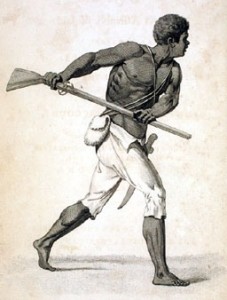Newspaper Report Of The Charles Deslondes Revolt Of 1811:
In 1811, another “largest slave revolt in American history” took place in New Orleans, Louisiana. During this revolt about 500 enslaved Africans, armed with pikes, hoes, axes and a few firearms, marched on the city of New Orleans with flags flying and drums beating. Many of the slaves had participated in the Haitian Revolution. This revolt was led by Charles Deslondes, a mulatto from Saint Dominique, Haiti. They were well-organized and used military formation dividing themselves into companies commanded by various officers. They showed a variety of military formations, but collapsed in combat against a well- armed militia and regular army troops under General Wade Hampton.
The events were as followed. On January 8, 1811 the rebellion began late in the evening on the plantation of Colonel Manuel Andy located in the German Coast County, some thirty-six miles northwest of New Orleans near present-day Norco. According to contemporary sources the leader of the revolt was a mulatto “a yellow fellow,â€� probably of Santo Domigan or Jamaican origin. He was the property of the Widow Jean–Baptiste Deslondes at the time of the uprising. Charles Deslondes was in the temporary employment of Colonel Andry or Andre, the sources use alternate spellings of his name.
Manuel Andry was wounded by an axe to the head by the rebels. His son Andry Jr. was killed and the slaves made their way from the Andry plantation to a prearranged rendezvous with a support group, which included slaves from neighboring plantations, runaway slaves who had been living in the woods, and a large number of “maroon� slaves.
They began their march along the river toward New Orleans, divided into companies each under an officer, with beat of drums and flags displayed marching toward Trepagnier Plantation. After killing Trepagnier, from this rendezvous point the insurgents move southeast on the River Road toward New Orleans, attacking other plantations along the way, burning several and adding arms and additional recruits. By the following afternoon they had arrived at the Jacques Fortier plantation some “five leagues� distant where they “commenced killing poultry, cooking, eating, drinking and rioting.�[i]
People began coming into New Orleans as word arrived in New Orleans about the slave rebellion. Carriage after carriage, loaded with white families and a few personal belongings, began pouring into town within hours of the initial rising.
Within twenty–four hours after the initial attack under the leadership of Manuel Andry some 80 local militia troops and vigilantes set out in pursuit of the rebels who now numbered five hundred. They attacked the rebels near the plantation of Francois Bernard Bernoudi where the rebels stood their ground with “colors displayed and full or arroganceâ€� with their leaders mounted on horseback.
General Wade Hampton was dispatched to the scene of the rebellion in command of a detachment of regular troops and two companies of militia to take charge of all the suppression forces. Additional assistance was on the way from Baton Rouge. A company of dragoons and one light artillery under the command of Major Homer Virgil Milton. Hampton began pursuing the rebels into the woods on the morning of the 10th. The insurrectionary were armed with cane knives, axes, hoes, other tools and a few small arms.
General Hampton’s force joined with that of Major Milton at Destrehan plantation and crushed the revolt. Hampton informs Claiborne that the chief leadership of the revolt “are taken.� By ten o’clock in the evening of January 11, Andry wrote Claiborne that the insurrection was completely broken and that the leaders, including Charles Deslondes, had been killed or captured.
Sixty were killed in the battle, seventeen missing and sixteen taken captive and held for trial. Trial for those captured for participation in the revolt was held almost immediately. Twenty-one accused were placed on poles along the German Coast. Three of those implicated were judged innocent and six pending further investigation. What happened to the six is not known.
The court records written in old French provide additional details of this major revolt in Louisiana. Charles mulatre [mullatoe] is identified as the chief organizer and black Zenon as the main rebel. Other leaders included Gilbert and Pierre Mul of André; Anis of Wagram, Mathurin of a Broussard, who commanded with a sword. Cupidon testified that Mathurin commanded with a sword and that he was the most famous rebel and that they marched willingly,�‘de bonne volonte.� Quamana of Brown and Harry Mul of Kenner spent Saturday night at Andry’s to discuss the revolt with Cha. He testify that he hit Francois Trepagnier with an axe after he was already dead, and he set fire to houses of Vacherie and Rene Pere. Kooche admits guilt, but denies he hit Trepagnier with an axe.
During the court trial the leaders attempted to out do other in explaining the major role they played in the revolt. Following in this vein, Quamana admitted his guilt and that he figured in a remarkable manner way. Robaine figured in the revolt outstandingly, “maniere marquess,� dans la revolution. Dagobert had not seen him since, “ne puls avoir figure d’une maiere marquee dans la revolution. Dagobert is described as “Augustin chief.� Jean de Arnault’s testified that Dagobert was one of the most famous leaders, the most zealous “Le plus famous brigades.�
Other rebel leaders and participants identified are: Chief leader Charles Deslondes, primary leaders Quamana, Cha, Dagobert, Robaine, Jean de Arnault, and Hypolite. Insurgents included Joseph Espanol, Louis of Trepagnier, Etienne, Gabriel, Raymond of Alex Labranche, Eugene, Jean, Thomas, Jean Baptiste, Baptiste Bernard, Louis of Trepagnier, Colas, Valentine, Cesar, Jacques Delhomme,
[i] The Louisiana Gazette and New Orleans Daily Advertiser Thursday, January 10. 1811